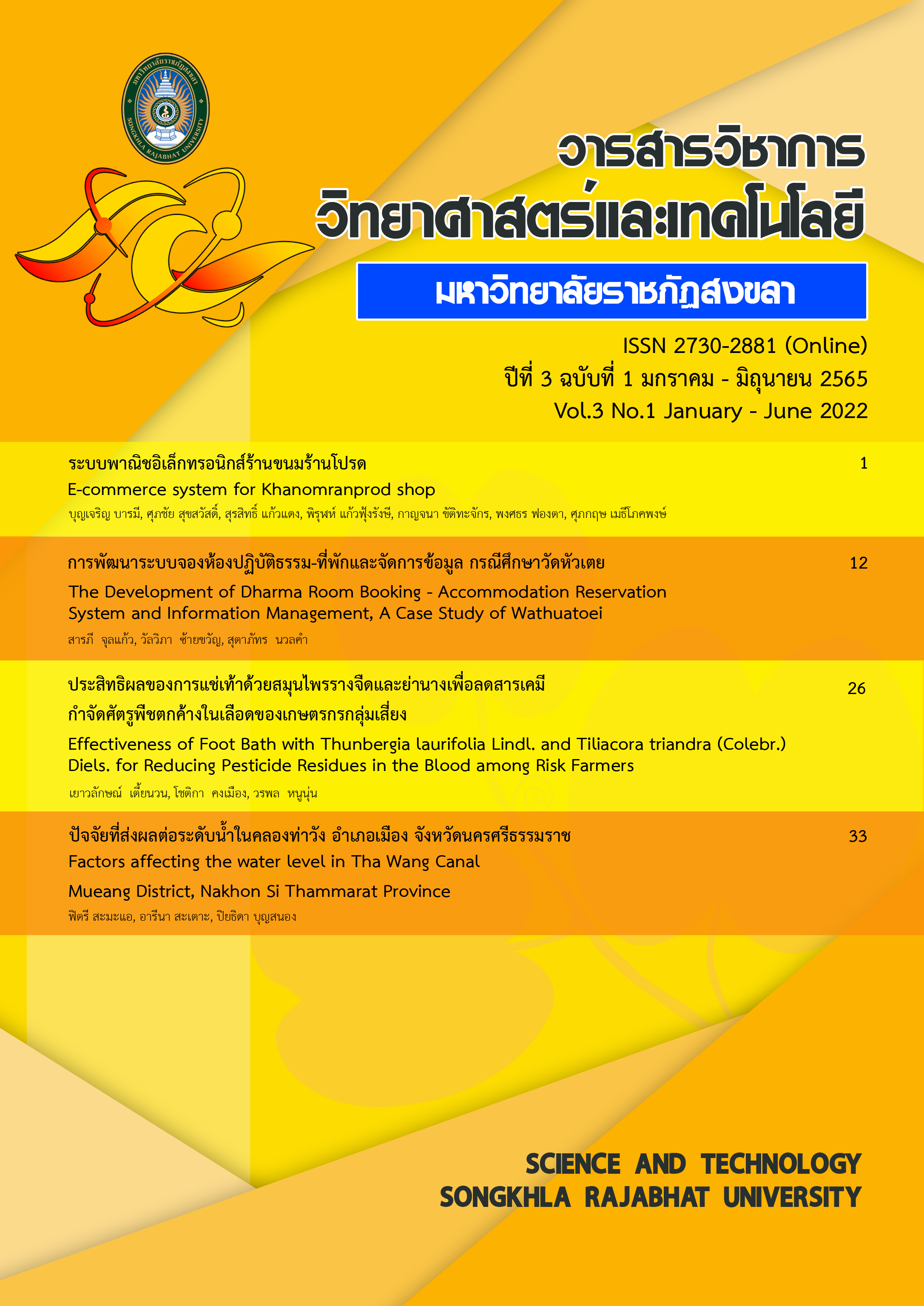ปัจจัยที่ส่งผลต่อระดับน้ำในคลองท่าวัง อำเภอเมือง จังหวัดนครศรีธรรมราช
คำสำคัญ:
water level in canal, Multiple Linear Regression Analysis, atmospheric pressure at moderate sea level, Daily rainfall, maximum temperatureบทคัดย่อ
การวิจัยครั้งนี้ มีวัตถุประสงค์เพื่อศึกษาปัจจัยที่ส่งผลต่อระดับน้ำในคลองท่าวัง อำเภอเมือง จังหวัดนครศรีธรรมราช ปัจจัยที่นำมาศึกษาคือ ปริมาณน้ำฝนสะสมรายวัน ความชื้นสัมพัทธ์ อุณหภูมิสูงสุด และความกดอากาศที่ระดับน้ำทะเลปานกลาง ผู้วิจัยใช้ข้อมูลแบบทุติยภูมิ จากระบบติดตามสถานการณ์น้ำทางไกลอัตโนมัติ กองวิเคราะห์และประเมินสถานการณ์น้ำ กรมทรัพยากรน้ำ กระทรวงทรัพยากรธรรมชาติและสิ่งแวดล้อม และศูนย์อุตุนิยมวิทยาภาคใต้ฝั่งตะวันออก ทำการเก็บข้อมูลตั้งแต่ 1 มกราคม ถึง 31 ตุลาคม 2566 เป็นรายวัน รวม 263 วัน วิเคราะห์ข้อมูลด้วยการวิเคราะห์ถดถอยเชิงเส้นพหุคูณ ด้วยวิธีเพิ่มตัวแปรอิสระแบบขั้นตอน ผลการวิจัยพบว่า ปริมาณน้ำฝนสะสมรายวัน ( ) และความกดอากาศที่ระดับน้ำทะเลปานกลาง ( ) ส่งผลต่อระดับน้ำในคลองท่าวังในทิศทางเดียวกัน และอุณหภูมิสูงสุด ( ) ส่งผลต่อระดับน้ำในคลองในทิศทางตรงกันข้าม แต่ความชื้นสัมพัทธ์ ( ) ไม่ได้ส่งผลต่อระดับน้ำในคลอง อย่างมีนัยสำคัญทางสถิติ 0.05 และสมการพยากรณ์คือ โดยปริมาณน้ำฝนสะสมรายวัน อุณหภูมิสูงสุด และความกดอากาศที่ระดับน้ำทะเลปานกลาง สามารถอธิบายความแปรผันของระดับน้ำในคลองท่าวังได้ 40.5% และเกิดจากปัจจัยอื่น ๆ ที่ไม่ได้ศึกษา 59.5% ดังนั้นสมการพยากรณ์นี้มีความเหมาะสมในการนำไปพยากรณ์ระดับน้ำในคลองท่าวัง จังหวัดนครศรีธรรมราช เมื่อระดับน้ำในคลองท่าวังมีค่าสูงกว่า 3.15 เมตรเทียบกับระดับน้ำทะเลปานกลาง (ระดับเตือนภัยน้ำท่วม) และระดับน้ำต่ำกว่า 0.45 เมตร เทียบกับระดับน้ำทะเลปานกลาง (ระดับเตือนภัยน้ำแล้ง) เพื่อเป็นการเฝ้าระวังในการรับมือกับน้ำท่วมและภัยแล้ง ได้ทันท่วงทีเพื่อลดความเสียหายทั้งเศรษฐกิจในชุมชนและความเดือดร้อนของประชาชนในอำเภอเมืองนครศรีธรรมราช
เอกสารอ้างอิง
Bangphan, Surapong., Bangphan, Phiraphan. & Boonkang, Thitikan. (2013). Multiple Regression Analysis With Test Percentage For Good Rice : Part I (การวิเคราะห์การถดถอยพหุคูณโดยทดสอบกับเปอร์เช็นต์ข้าวดี ส่วนที่ 1). Engineering Journal Chiang Mai University, 1-7.
Chaowiwat, W. & Likitdecharote, K. (2009). Effect of climate change on potential evapotranspiration case study: lower Chaopraya basin. In proceeding of the 1 NPRU Academic Conference: 75-83.
De Macedo, MD., Alves, JD., Monteiro, AS. & Garcia, CA. (2017). Characterization of dissolved organic matter in an urbanized estuary located in Northeastern Brazil, Environmental monitoring and assessment, 189(6): 272.
Delpla, I., Jung, AV., Baures, E., Clement, M. & Thomas, O. (2009). Impacts of climate change on surface water quality in relation to drinking water production, Environment international, 35(8): 1225-33.
Department of Water Resource, Ministry of Natural Resources and Environment, Thailand [Online] Available at: https://www.dwr.go.th/article_list.php?category_id=5
Janthong, Tirapun & Thongsukplang, Hansasooksin Suwadee. (2021). Flood Risk Assessment and Mitigation Measures in Nakhon Si Thammarat City (พื้นที่เสี่ยงภัยน้ำท่วมและมาตรการบรรเทาภัยในเขตนครศรีธรรมราช). Sarasatr Journal 1: 250-260.
Promlao, Pacharapan & Sornwong, Piphat. (2021). A Study of Factors for the Analysis of Flood Risk Areas: A Case Study of Lower Mun River Basin (การศึกษาปัจจัยเพื่อวิเคราะห์พื้นที่เสี่ยงอุทกภัย กรณีศึกษาลุ่มน้ำมูลตอนล่าง). RSU International Research Conference 2021 on Science and Technology, 136-147.
Sangkarak, Sirirat., Phetrak, Athit., Kittipongvises, Suthirat. & Rattanapun, Patchapun. (2020). Impacts of climate change on resources and management (ผลกระทบของสภาพภูมิอากาศที่เปลี่ยนแปลงต่อทรัพยากรน้ำและการจัดการ). Environmental Journal, 24(1): 1-8.
Southeast Asia START Regional Center. (2006). Final technical report AIACC AS07: Southeast Asia Regional vulnerability to changing water resource and extreme hydrological events due to climate change.
Thai Meteorologlcal, Thailand [Online] Available at: https://www.tmd.go.th/weather/province/nakhon-sri-thammarat
ดาวน์โหลด
เผยแพร่แล้ว
รูปแบบการอ้างอิง
ฉบับ
ประเภทบทความ
สัญญาอนุญาต
ลิขสิทธิ์ (c) 2024 วารสารวิชาการวิทยาศาสตร์และเทคโนโลยี มหาวิทยาลัยราชภัฏสงขลา

อนุญาตภายใต้เงื่อนไข Creative Commons Attribution-NonCommercial-NoDerivatives 4.0 International License.
การดำเนินงานภายใต้ Attribution-NonCommercial-NoDerivatives 4.0



